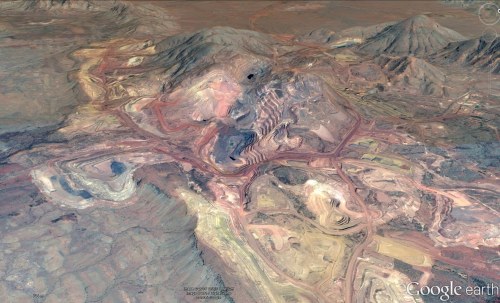A new explanation for banded iron formations (BIFs)
The main source for iron and steel has for more than half a century been Precambrian rock characterised by intricate interlayering of silica- and iron oxide-rich sediments known as banded iron formations or BIFs. They always appear in what were shallow-water parts of Precambrian sedimentary basins. Although much the same kind of material turns up in sequences from 3.8 to 0.6 Ga, by far the largest accumulations date from 2.6 to 1.8 Ga, epitomised by the vast BIFs of the Palaeoproterozoic Hamersley Basin in Western Australia. This peak of iron-ore deposition brackets the time (~2.4 Ga) when world-wide evidence suggests that the Earth's atmosphere first acquired tangible amounts of free oxygen: the so-called 'Great Oxidation Event'. Yet the preservation of such enormous amounts of oxidised iron compounds in BIFs is paradoxical for two reasons: the amount of freely available atmospheric oxygen at their acme was far lower than today; had the oceans contained much oxygen, dissolved ions of reduced Fe-2 would not have been able to pervade seawater as they had to for BIFs to have accumulated in shallow water. Iron-rich ocean water demands that its chemical state was highly reducing.

Oblique view of an open pit mine in banded iron formation at Mount Tom Price, Hamersley region Western Australia (Credit Google earth)
The paradox of highly oxidised sediments being deposited when oceans were highly reduced was resolved, or seemed to have been, in the late 20th century. It involved a hypothesis that reduced, Fe-rich water entered shallow, restricted basins where photosynthetic organisms – probably cyanobacteria – produced localised enrichments in dissolved oxygen so that the iron precipitated to form BIFs. Later work revealed oddities that seemed to suggest some direct role for the organisms themselves, a contradictory role for the co-dominant silica-rich cherty layers and even that another kind of bacteria that does not produce oxygen directly may have deposited oxidised iron minerals. Much of the research focussed on the Hamersley BIF deposits, and it comes as no surprise that another twist in the BIF saga has recently emerged from the same, enormous repository of evidence (Rasmussen, B. et al. 2015. Precipitation of iron silicate nanoparticles in early Precambrian oceans marks Earth's first iron age. Geology, v. 43, p. 303-306).
The cherty laminations have received a great deal less attention than the iron oxides. It turns out that they are heaving with minute particles of iron silicate. These are mainly the minerals stilpnomelane [K(Fe,Mg)8(Si, Al)12(O, OH)27] and greenalite [(Fe)2–3Si2O5(OH)4] that account for up to 10% of the chert. They suggest that ferruginous, silica-enriched seawater continually precipitated a mixture of iron silicate and silica, with cyclical increases in the amount of iron-silicate. Being such a tiny size the nanoparticles would have had a very high surface area relative to their mass and would therefore have been highly reactive. The authors suggest that the present mineralogy of BIFs, which includes iron carbonates and, in some cases, sulfides as well as oxides may have resulted from post-depositional mineral reactions. Much the same features occur in 3.46 Ga Archaean BIFs at Marble Bar in Western Australia that are almost a billion years older that the Hamersley deposits, suggesting that a direct biological role in BIF formation may not have been necessary.
--
__._,_.___

No comments:
Post a Comment